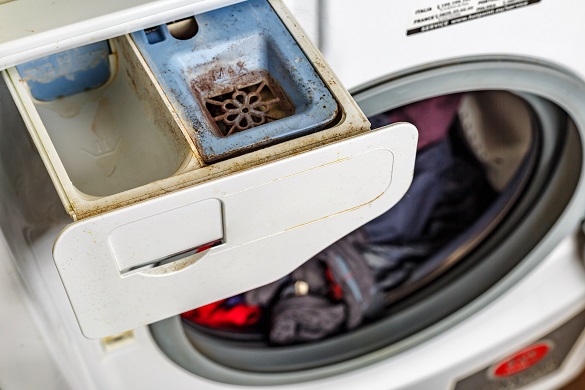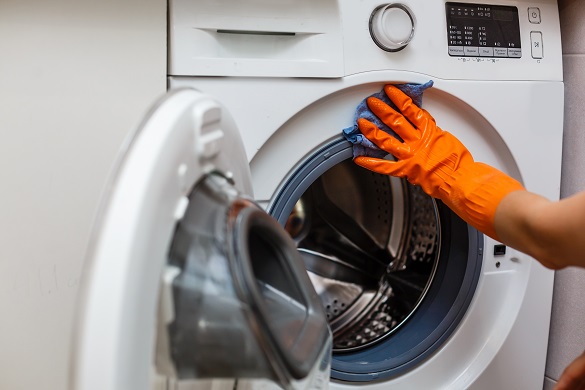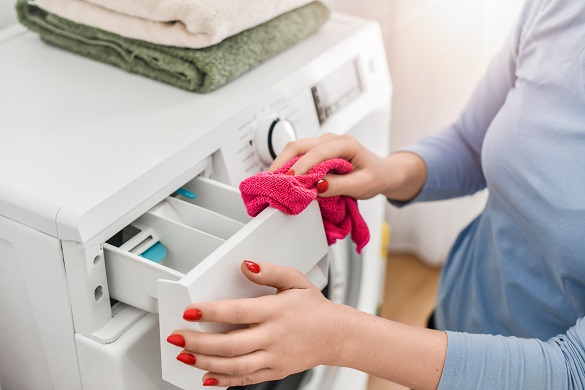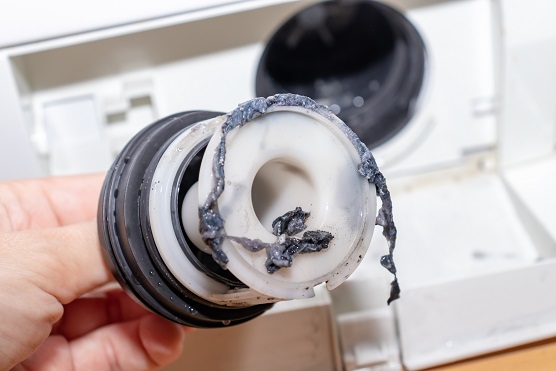Sniff. Sniff. Got a smelly washing machine on your hands? Don't worry if your laundry reeks of rotten eggs, drains or worse. We have lots of tips to help you clean your appliance and keep bad odours away.
Plus, if you’re in the mood for a deep clean, we’ve got guides full of washing machine care tips.
Why does my washing machine smell?

There are a few reasons why your washing machine might be smelly. Mould and old detergent could be lingering inside it somewhere. The drum, door seal and detergent drawer are all hot spots for dirt and grime.
Something else that could be causing your machine to smell is a dirty or blocked filter. You need to remove and clean this often to stop bacteria spreading and debris clogging up.
How to clean a washing machine to improve the smell
Here's what to do to get your machine smelling fresh again (you might need to try a few of these steps). But first, check you have:
- A cloth and scrubbing brush
- Washing up liquid
- An old toothbrush
- Towels
- A shallow tray
- Drain cleaner
- Rubber gloves
Run a service wash

A service wash is when you run the washing machine empty at a very high temperature. Some models come with a self-cleaning or service wash setting. With others, you choose the highest available temperature (normally around 90 degrees Celsius).
Once you're confident about the setting, make sure the machine is empty and run the service wash.
Extra hot washes cost more to run than your usual 40-degree wash. So, you don't want to be reaching for this setting all the time. A service wash a month should be enough.
Clean the rubber seal

The rubber door seal stops water leaking onto the floor. Because it’s constantly exposed to moisture, it’s easy for mould to develop in its folds. If you're already cleaning it regularly, a wipe with a clean cloth and washing up liquid in warm water is all you need. If there's visible mould, scrub it off with an old toothbrush.
Wash the detergent drawer and lint filter

Before following our step-by-step instructions, check your machine’s user manual for specific advice on cleaning these parts. With some models, you can’t remove the detergent drawer.
How to clean the drawer:
1. Pull it out completely (only if it’s removable)
2. Soak it in warm, soapy water for an hour
3. Scrub the awkward gaps with an old toothbrush
4. Clean the drawer’s compartment with a scrubbing brush or cloth
How to clean the filter:

- Switch off your machine and unplug it from the mains
- Put towels on the floor and lay a shallow tray on top
- Remove the filter cover at the bottom
- Unscrew the filter cap in an anti-clockwise direction
- Let any escaping water drain into the tray and remove any loose objects like coins or keys
- Wash the filter under warm water
- Spin the impeller (a plastic propeller at the back of the filter) with your fingers to clean off any debris
- Put the filter back and close the cover
- Turn the machine back on
Air out the machine
After using your machine, leave the door slightly open to let the drum dry. If you shut it right away, the drum and door seal stay damp, making it easier for mould and bacteria to grow.
Check your standpipe
If you’ve tried all of the above and the smell is still hanging around, check for a blockage in the standpipe or connecting drain. The standpipe is the U-bend pipe that attaches the washing machine’s drain hose to the drain.
You’ll need to move your machine away from the wall to access these parts. And remember to put towels down in case there’s debris or water inside the hose. Before you check the drain hose for clogs, switch off your machine, as well as your home’s water supply . You may also need to remove some metal clamps holding it in place.
If you can’t see anything, something could be blocking the standpipe or drain. A drain cleaner might do the trick, but be careful when pouring it in (you don’t want it to overflow). You should also take care when reconnecting the drain hose to the standpipe – don’t push it in too far.
How to stop your washing machine from smelling

As mentioned, it's important to leave the machine's door open after every use. This way, the moisture can escape, making it less likely for mould to grow.
You should also carefully read the labels on your detergent and fabric conditioner to ensure you're not using too much. Not only does excess detergent get on your clothes, but it also leaves a residue inside your machine, which will become dirty and mouldy if it's not cleaned off.
Other things to consider are wiping down the outside regularly and removing your laundry as soon as it’s finished. Leaving damp clothes longer than necessary can also cause mould to develop.
Protect your washing machine
Worried about the cost of repairing or replacing your machine if it stops working? Keeping it clean and well-maintained will help it run smoothly for longer. But if you want that extra peace of mind, our appliance cover includes protection against accidental damage and breakdown.
Our blog is loaded with more related articles

Washing machine tips
5 ways to fix your washing machine
Always make sure that you switch off the electric and water supplies to your washing machine before you start any maintenance a...
Read more

Washing machine tips
How to disconnect your washing machine
Read our comprehensive guide for step-by-step instructions on how to safely disconnect your washing machine, tumble dryer and o...
Read more

Washing machine tips
How to extend the lifespan of your washing machine
The humble washing machine is the workhorse of a household. By following some simple hints and tricks you could add a few more...
Read more
